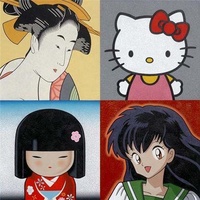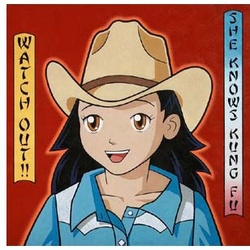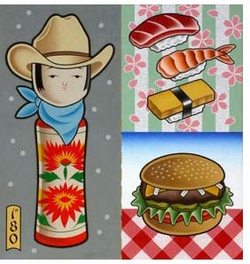Margaret Kasahara was almost half an hour late to the opening reception of her first Denver solo exhibit, at the Sandra Phillips Gallery along the Arts District on Santa Fe Drive. Her fans, friends and collectors milled around soaking in the art on the wall, and made chit-chat until she entered, flustered from being stuck in traffic on this rainy spring evening.
The Colorado Springs-based painter began making the rounds, and one acquaintance made slight of the fact that she was late — it’s no big deal, she told Margaret, who gave a wan smile in return. “No, I bet she’s mortified,” I said. “Japanese are supposed to be early to things. It’s in our DNA.”
I wondered if I had offended her by saying it, but the quip fit the exhibit — Kasahara’s work is a statement of her very Japaneseness , her Asian values on display in colorful two dimensions.
Besides, tardiness didn’t matter. Late or not, her opening was a hit, with a big crowd in spite of the lousy wet weather. The space is small, and her main pieces are 4 feet by 4 feet square, so there’s only room for 13 works in the gallery. But that’s enough to give you a scope of Kasahara’s ability with oil paint (and oil paint sticks) as well as her wit and clever vision, which infuses statements about race and identity in an engaging package of pop art and yes, politics, even though in her artist’s statement Kasahara says she’s not a particularly political artist:
As a child growing up in Boulder, Colorado in the 1970’s, I was profoundly aware of the “otherness” of my appearance and how the attitudes of those around me contributed to my sense of self—attitudes that were often based on assumptions. One person’s “exotic” was my “everyday”, and I was left with the feeling of not quite being allowed to belong. There were very few Asians in the community and I was often the only Asian in my classes. And in the broader cultural landscape, there weren’t many Asian American women role models. Depictions of Asians in film and television were mostly two-dimensional if and when they existed at all.
I started to use cultural symbols metaphorically in my artwork in 2002 when I was invited to participate in a “Color” show. It was at that time I realized I wanted to address my own “color” and began a series of drawings and paintings based on some of the stereotypes and misunderstandings that I encountered as a child—and occasionally experience to this day. And although I don’t consider my work to be of a political nature nor do I have an agenda, how I look does affect my sense of identity. Asian Americans still encounter misconceptions based solely on their appearance—a perception that I continue to explore in my artwork. It is a personal approach.
Before she started expressing her Asian-ness, Kasahara was known for her still lifes, and was gaining notice for them. The New York-born, Boulder-raised artist had moved to Colorado Springs in the late 1980s, so she was there when I served a stint as the art critic for the daily newspaper, Gazette in the early 1990s. It’s a wonder that our paths never crossed. But then again, I wasn’t a “born-again Asian” at the time, and probably wouldn’t have connected with the imagery she paints today. I wasn’t meant to meet her until now. That’s how karma works.
Walking around the gallery before her arrival, I was struck by how likable her imagery is. Partly, that’s because of the ubiquitousness of many of the icons she uses.
The painting that lends its title to the exhibit, “Role Models” (shown above) includes very specific images such as Hello Kitty and a familiar geisha detail from a 19th century Japanese woodblock, but also a generic kokeshi doll (a traditional carved wooden doll with a head on a body with no arms or legs) and a girl (self-portrait?) snatched from an anime or manga with requisite large eyes and sailor-suit schoolgirl outfit. These are all very familiar representations of Japanese women that are like blank screens for Westerners to project all their hopes, fantasies and stereotypes upon. For Asian women, these are role models to both appreciate and avoid. They’re popular, but completely open to interpretation by the viewer. A European American woman who was also waiting for the artist asked the gallery owner if the painting was available in smaller sizes, as if Kasahara cranks out multiple versions of these works like a cheap street vendor cranking out oils of women with parasols standing on a beach.
I mentioned that it would be cool to see the work as a lithograph, or maybe even published as a poster. “Oh, I only want the Hello Kitty part,” she said. “I love Hello Kitty.” She missed the point.
But the art works on multiple levels, so if someone wants to enjoy the pop references as mere entertainment, that’s certainly there. Others may see the sheer quality of the art — the careful precision of the grids, straight edges and smooth shiny surfaces. As objects, these paintings are gorgeous, stroked to a soft sheen that almost glows; it’s only when you look closely that you can see the strokes of brush and paint stick, to show the artist’s presence and prove these aren’t manufactured images. (Some of the pieces still smelled of linseed oil — a true artist works feverishly until the last minute before delivering the work to the gallery….)
Other large paintings were full of meaning for me, even though they may have held entirely different meanings for others in the gallery. It’s all in the context of the viewer’s life experience, I suppose.
Another large painting, “Lookalike,” is a grid — not unlike Andy Warhol’s commodified presentations of celebrities and soup cans — of kokeshi dolls, but all with slight variations in the pattern, hair, face… a reflection of how we’re all different but in the West, seen as all the same. A third painting, “Chibichan Cowgirl” shows an anime girl in a cowboy hat, with text in “wonton” font that says, “Watch out!! She knows kung fu.” The image is a visual mashup of east and west, but with the too-common “ching-chong” misconception of Asian culture signified by the font (for many Asian Americans, “wonton” is a stereotype) and the mis-use of kung fu (anime is Japanese; kung fu is Chinese). Like “Lookalike,” it’s a statement about how Asian Americans are perceived.
For me, each painting resonated as running commentary on racial stereotypes that have been foisted on Asian Americans for a couple hundred years, or as spot-on homages to Kasahara’s roots One of my favorites is a small painting on the back wall, which features a tea leaf, tea cup, fish and a kaki, or persimmon (my favorite fruit). It’s not a political statement, just a lovingly rendered homage to her (and my) culture.
One other painting that caught my eye is “Americanese 180 Degrees,” a reflection of Japanese American identity which features a kokeshi doll wearing a cowboy hat and bandana, sushi (the most recognizable Japanese food for Americans) and a cheeseburger. Here the icons are both Japanese and American, and reminds me of 1966, when I was 8 years old and my family moved from Japan. That summer, I discovered McDonald’s (the chain hadn’t arrived in Japan yet) and my life — and diet — hasn’t been the same since.
There’s a book at the back of the room at Sandra Phillips that has photos of other work by Kasahara (my favorite title, “Cheese Nips,” is a pair of kokeshi dolls with bodies made of cheese). The book also has reviews of other shows she’s been in, including one at the Japanese American National Museum last year. When she was out in LA, for that show, she was interviewed for JANM’s sister site, “Discover Nikkei .”
I spent longer at the gallery than I do at most museums, soaking up Kasahara’s art, and I plan to return while the work is still up.
The next day, I got an email from Margaret that confirmed by comment about being late. “You are so right — it just about k-i-l-l-e-d me knowing how late I was to my own opening!” She wrote. “Sooooo embarrassing~”
And … soooo Japanese!
The exhibit will be up through July 3 at the Sandra Phillips Gallery , 744 Santa Fe Drive, Denver, Colorado, and it’s worth seeing if you’re a fan of Asian pop culture or of fine painting.
*This article was originally published in NIKKEI VIEW: The Asian American Blog on May 20, 2010.
© 2010 Gil Asakawa









